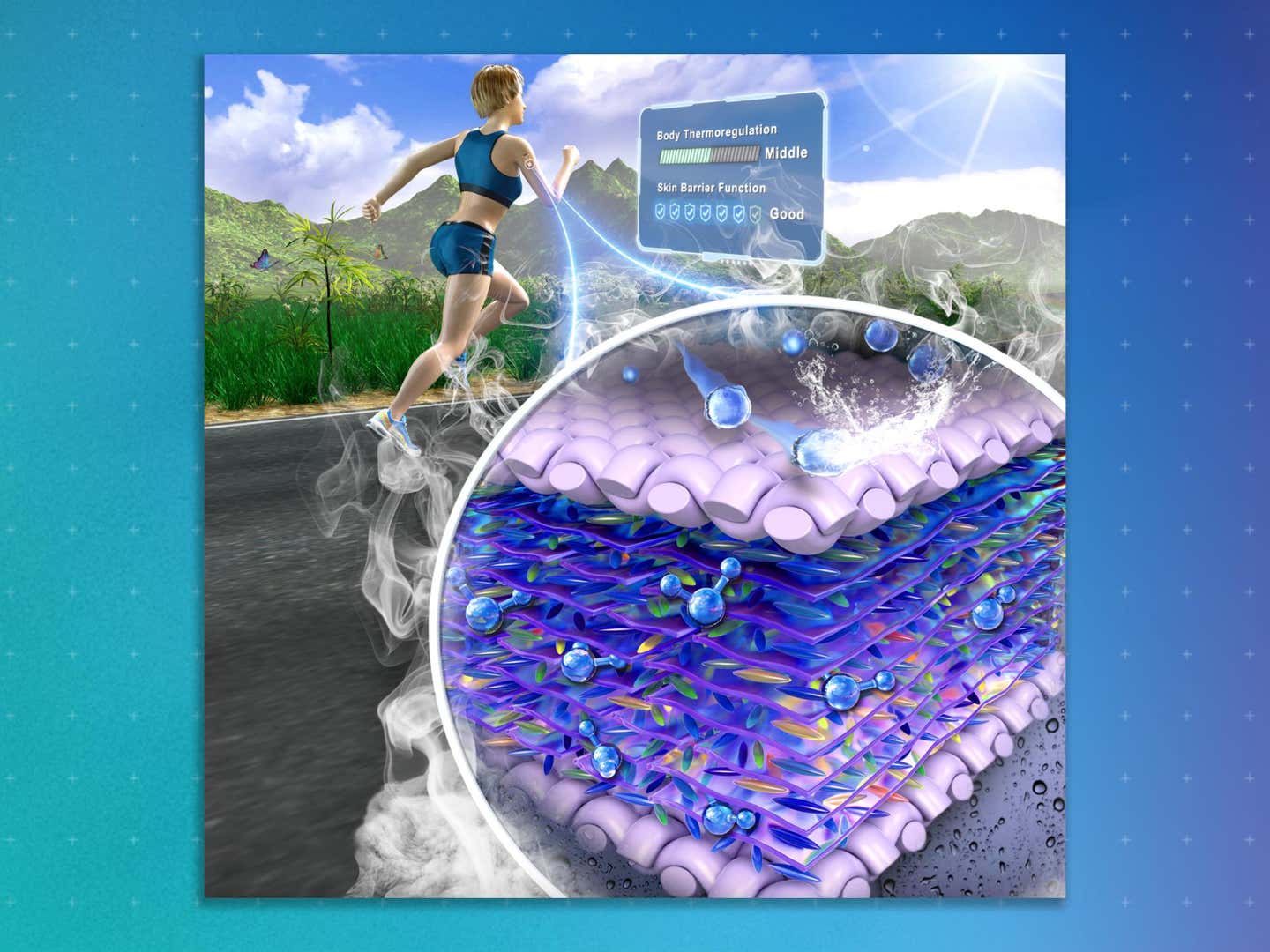Novel biosensor measures body sweat vapors to diagnose diseases
Using wearable sensors, a person’s sweat production and characteristics can be monitored to gather information about their skin and health.

[Feb. 27, 2023: Staff Writer, The Brighter Side of News]
A biosensor developed by Huanyu “Larry” Cheng, the James L. Henderson, Jr. Memorial Associate Professor of Engineering Science and Mechanics, features superhydrophobic material that measures sweat vapor without absorbing water. (Credit: Larry Cheng/Penn State)
Sweat is a rich source of biomarkers that can aid doctors in diagnosing health conditions. By using wearable sensors, a person's sweat production and characteristics can be monitored to gather information about their skin, nervous system activity, and underlying health issues. However, current sensors are unable to detect all types of sweat, as not all sweat is equal. To address this limitation, a new superhydrophobic biosensor has been developed that could serve as a diagnostic tool to identify and measure such sweat types.
The sensor, developed by Huanyu “Larry” Cheng, James L. Henderson, Jr. Memorial Associate Professor of Engineering Science and Mechanics, was featured in a paper published in ACS Nano.
Sweat can be divided into two types: sensible (liquid) and insensible (vapor). Sensible sweat is easily noticeable by individuals, especially during intense exercise, and can be continuously monitored through wearable sensors in a non-invasive way. On the other hand, insensible sweat is characterized by the loss of water from the skin, and is secreted at a much lower rate during periods of low-intensity exercise or rest. Measuring insensible sweat is challenging, according to Cheng.
“Monitoring insensible sweat is of high interest for evaluating skin health and disease conditions, such as eczema and wound healing, as well as underlying health statuses, such as pain or anxiety,” Cheng said. “Skin-interfaced devices that detect sweat rate and loss are currently limited to working with sensible sweat and are not suitable for insensible sweat in a vapor state.”
Related Stories:
A prototype of a superhydrophobic sweat sensor has been developed by Cheng to measure insensible perspiration vapor. This sensor consists of a superabsorbent hydrogel composite layer on a porous substrate, which is enclosed between two superhydrophobic textile layers. This design enables the passage of sweat vapor while safeguarding the sensor from the impact of external water droplets from sensible perspiration. To continuously monitor sweat rates across various body locations, this sensor could be combined with a flexible wireless communication and power module.
“Proof-of-concept demonstrations on human subjects showcased the feasibility to continuously evaluate the body’s thermoregulation and skin barrier functions,” Cheng said. “This enables the assessment of thermal comfort, disease conditions and nervous system activity and provides a low-cost device platform to detect other health-relevant biomarkers in the sweat vapor as the next-generation sweat sensor for smart healthcare and personalized medicine.”
Which diseases can be monitored by sweat analysis?
Sweat contains many chemicals and biomarkers that can be used to monitor various diseases and health conditions. Here are some examples:
Cystic Fibrosis: Cystic fibrosis (CF) is a genetic disease that affects the respiratory and digestive systems. People with CF have high levels of chloride in their sweat, so sweat testing can be used to diagnose the disease and monitor its progression.
Dehydration: Sweat testing can be used to monitor dehydration, which occurs when the body loses more water than it takes in. Dehydration can lead to a variety of symptoms, including dry mouth, thirst, fatigue, and dizziness.
Diabetes: Sweat contains glucose, which can be used to monitor blood sugar levels in people with diabetes. Sweat testing may also be useful for people who have trouble with traditional blood glucose monitoring methods.
Parkinson's disease: Parkinson's disease is a neurodegenerative disorder that affects movement and coordination. Studies have found that sweat contains biomarkers that can be used to monitor the disease's progression.
Cancers: Some cancers, such as melanoma, can release specific biomarkers into sweat that can be detected through specialized testing.
Which wearable sensors, currently on the market, monitor sweat
There are several wearable sensors on the market that can monitor sweat and provide valuable insights into health and fitness. Here are a few examples:
Fitbit Sense: The Fitbit Sense is a smartwatch that includes a skin temperature sensor and an electrodermal activity (EDA) sensor, which measures changes in sweat gland activity to track stress levels.
Gatorade Gx Sweat Patch: The Gatorade Gx Sweat Patch is a disposable patch that attaches to the skin to measure sweat levels during exercise. It provides information on sweat rate, sweat sodium concentration, and fluid loss to help athletes optimize their hydration.
Kenzen ECHO Smart Patch: The Kenzen ECHO Smart Patch is a wearable patch that measures sweat levels to track hydration, electrolyte balance, and core body temperature. It is designed for use in sports and fitness activities.
SLOCK: The SLOCK sensor is an electrochemical sweat-based biosensing platform designed for the diagnosis and management of circadian abnormalities.
Epicore Biosystems Soft Wearable Health Monitor: The Epicore Biosystems Soft Wearable Health Monitor is a flexible, skin-like patch that adheres to the skin and measures various health parameters, including sweat levels. It can be used for remote patient monitoring and disease management.
Overall, sweat testing has the potential to be a noninvasive and convenient method for monitoring a range of health conditions. However, more research is needed to develop and validate these tests for clinical use.
A superabsorbent hydrogel composite on a porous substrate is sandwiched between two superhydrophobic textile layers to allow the permeation of sweat vapor while preventing the sensor from being affected by the external water droplets of sensible perspiration. (Credit: Larry Cheng/Penn State)
Cheng’s work was supported in part by the National Institutes of Health, the National Science Foundation and Penn State. The National Natural Science Foundation of China, the Natural Science Foundation of Hunan Province and the Furong Scholars of Hunan Province program also provided support.
Co-authors include Shangda Chen, Xiaofeng Li, Yujing Li, Weiyi Liu, Yangchengyi Liu, Shun Qian, Yi Sun, Yao Tian, Peihe Wang, Xiufeng Wang, Fengzhen Yang, Hanlin Yang and Ping Zhang, all affiliated with Xiangtan University in China.
For more science and technology stories check out our New Discoveries section at The Brighter Side of News.
Note: Materials provided above by the The Brighter Side of News. Content may be edited for style and length.
Like these kind of feel good stories? Get the Brighter Side of News' newsletter.



